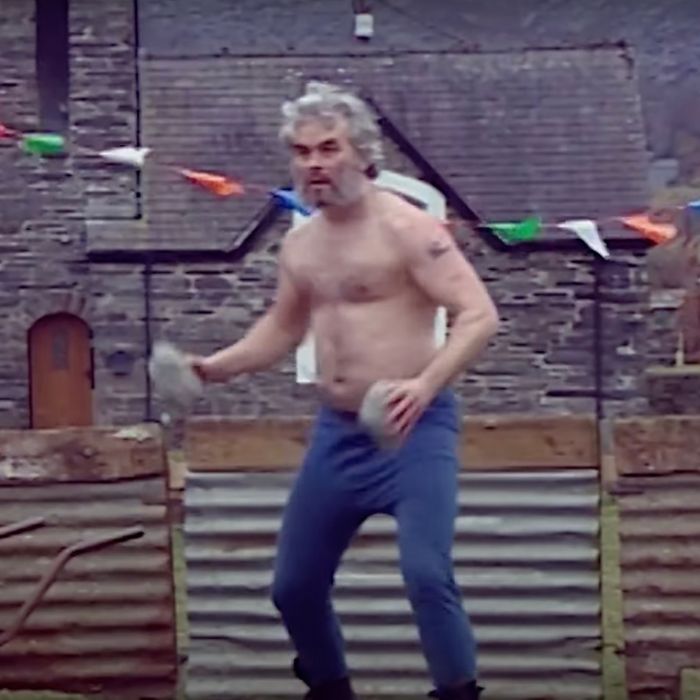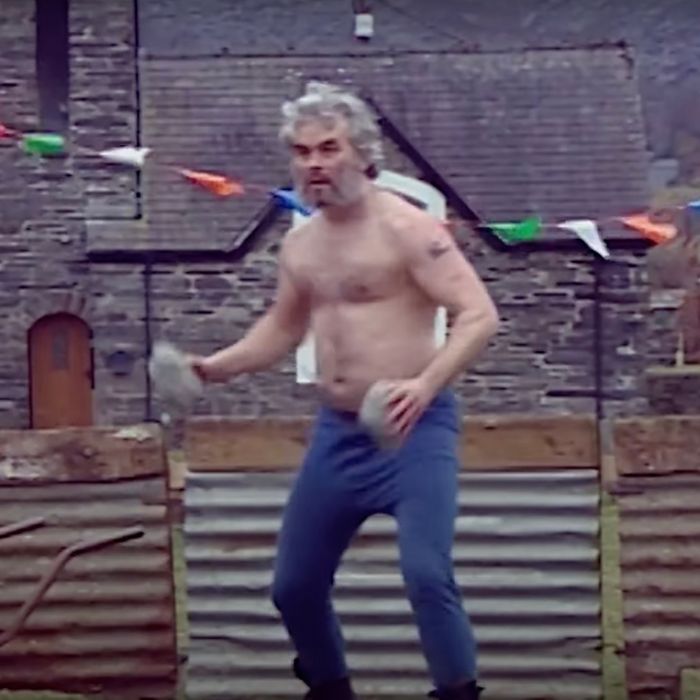
Photo: IFC
No sport has inspired more great films than boxing: Raging Bull, Body and Soul, Rocky, The Set-Up, Fat City, Ali, Girlfight, Creed. Or more great writers, either: Jack London, A. J. Liebling, James Baldwin, Gay Talese, George Plimpton, Norman Mailer, Joyce Carol Oates. (Only baseball might come close on this front.) It’s not that hard to understand why. Inside the ring, boxing is a raw expression of masculinity, full of drama and brutality and a poetry that was dubbed “the sweet science” in 1813, when a British journalist, Pierce Egan, was describing the country’s bare-knuckle fight scene. Outside the ring, it’s both natural fodder for domestic terror and a noir-inflected magnet for gangsters, gamblers, and other colorful characters who operate in the shadows.
It is also a sport where two guys beat the shit out of each other.
“How They Threw Rocks,” an ingenious riff on Leon Gast’s landmark 1996 documentary When We Were Kings, scores laugh after laugh on the essential barbarity of boxing and the flowery words that often accompany it. The writer, Seth Meyers, seems to have asked himself the question: What could be more punishing than two burly men throwing fists at each other? And the answer is “rocks.” The “oohs” of the crowd whenever Mike Tyson flattened an opponent in the first round with a thunderous right uppercut would surely only increase with the dull thud of a rock making contact with a man’s head. Indeed, there are times when the visceral impact is so extreme that the episode is a little hard to watch.
Mailer and Plimpton are among two of the voices, parodied ruthlessly here, in When We Were Kings, which is about the “Rumble in the Jungle,” the heavyweight championship bout between Muhammad Ali and George Foreman on October 30, 1974, in what was then Zaire and is now the Democratic Republic of the Congo. The scope of Gast’s documentary is too vast for “When They Threw Rocks” to attempt to capture, since it also dips into the political controversies of holding the fight in a country under dictatorial rule and intersects with the Zaire 74 music festival, which included performances by B.B. King and James Brown. But the episode does mimic many of the essential dynamics: an aging legend squaring off against a heavily favored challenger who makes up in brute force what he lacks in charisma. A profound bond between the older boxer and the locals, signified by a call-and-response from the crowd. And, of course, the famous “rope-a-dope” trick of absorbing punches for most of the fight until the opponent wears himself out.
“How They Threw Rocks” opens in the same year, 1974, in the Welsh village of Llagoelwyn On Wrst, home of Alwyn Lewis-Ifans (Trystan Gravelle), beloved champion of the not-so-sweet science known as Craig Maes. Having just returned from prison for maiming a politically connected sheep thief, Allie has lost years of his prime and gained quite a bit of weight, which his nonstop eating and beer-swilling is doing little to curb. Meanwhile, his Goliath of a challenger, Sior Strawboss (Sam C. Wilson), has been leveling opponents through an effective strategy of throwing rocks really, really, really hard at their heads and sternums. Allie is the Ali of this scenario — a long(ish)-in-the-tooth folk hero with a quick wit and a balletic style; Strawboss is the Foreman-like lug, an imposing puncher who doesn’t yet have the personality to sell fat-reducing countertop grills.
As always with Documentary Now!, much of the fun in “How They Threw Rocks” comes from a keen deconstruction of the source material. For When We Were Kings, Gast spent two decades piecing together film footage of Zaire in 1974, and the textures here match beautifully, with lots of beautiful lens flare leaking into shots of the Welsh countryside and echoes of memorable shots, like Allie/Ali connecting with the local children. But the funniest touch here is the back-and-forth between two talking heads, Owen Teale-Griffith (Jonathan Pryce) and Garth Davies-Gruffudd (John Rhys-Davies), whose rivalry becomes a subplot all its own, due mainly to Owen’s penchant for irritating Garth with his poetic reminiscences.
The Owen-Garth intrigue recalls the most inspired bit from the great HBO tennis mockumentary 7 Days in Hell, which digressed from a passage about a player’s legal troubles to eulogize a Swedish courtroom sketch artist who illustrated trials with cartoon animals. Here, Meyers seizes the opportunity to take the stuffing out of self-satisfied ring writers who would use a consequential fight like Ali-Foreman to appoint themselves official mythologists. “I once wrote, ‘When Strawboss strikes another man with a stone, even God winces,’” says Owen. “I was quite pleased with that one.” It’s a delightful little narrative arc, ending with Garth being so infuriated by Owen’s commentary (“It’s not a poem, it’s an elegy”) that he tells him to “shut the fuck up.” (The casting of Pryce and Rhys-Davies — one effete, the other gruff and salt-of-the-earth — is particularly inspired.)
As for the fight itself, it has the basic structure of the Ali-Foreman match: The champ looks thoroughly overmatched in the early rounds, adopts a mystifying strategy to protect a lead he doesn’t have, and then dramatically turns the challenger’s exhaustion against him. Here, Allie ineffectually lobs the mysteriously few rocks he’s collected from the surrounding fields and Strawboss counters with a single hurl so hard that it knocks him to the ground. From there, Allie stands at the far end of the ring (i.e., sheep pen) and shows Strawboss his back, a defensive technique known as “turtling.” By the last round, of course, Strawboss has thrown all 519 of his rocks — Allie surprised many with his ability to count — and is now tired and vulnerable and ready to be slain.
“How They Threw Rocks” weaves in other hilarious bits of intrigue, too, like Allie’s gambling problem (“He loved to wager on how many of a thing was in any given place”) and his political rabble-rousing on behalf of local farmers (and the poor abducted “sheep-sheep” penned in with mountain sheep). And it’s worth pausing to scan some of the other headlines in the Llagoelwyn newspaper, like “Inflation Clams Mussel Business.” But mostly, the episode pokes affectionately at the distance between the poetry surrounding the sport of boxing and the brute reality of it. Ali and Allie were masters at both.
• A small thing, but the inclusion of the 2019 documentary Honeyland in the Documentary Now! title sequence, alongside more familiar titles like Roger & Me and Hoop Dreams, is a worthy piece of canonization. It’s a superb portrait of a North Macedonian beekeeper who’s trying to keep her centuries-old craft intact as neighbors encroach on her territory.
• Strawboss, a man of few inelegant words: “He may have just got out of jail. But after the fight, he’ll want to go back to jail where I can’t get to him, see? Because of the jail bars.”
• “He was heavier, which was problematic for a fighter whose style was to be elusive.”
• Owen: “‘He had the air of a man looking for a dropped wedding ring he wasn’t sure he wanted to find.’ I liked that one quite a bit.”
• Owen, again: “I turned to Garth and I said, ‘Strawboss is the nail that cracked the hammer.’ And I’ll never forget what Garth said to me. He said, ‘Owen, that’s enough.’”







